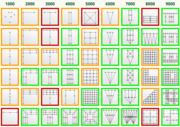Kiwi
The fruits of the kiwi are vitamin-packed and delicious. They are often grown as espalier fruit in warmer, wine-producing regions. Facade greening with kiwis on orphaned grapevine trellises has been in practice since around 1970. Because of their very vigorous growth, kiwi plants need a lot of space and need to be trimmed several times in summer. Kiwis work beautifully on pergolas, which is also how they are most often cultivated. They are a good choice for very high greening projects, for covered alleys, and similar projects. The mini-kiwi, as well as the arctic kiwi ('hardy kiwi'), are interesting alternatives for rougher or cooler climates.
Latin.: Actinidia chinensis / deliciosa

To thrive... where to find...
Kiwi regularly bears fruit only in warm climates. Outdoor cultivation (on a pergola or similar) with consistent yields is really only possible in regions also fit for viticulture. Kiwi can be grown in colder climates if it is trellised against a wall or facade or grown in a greenhouse. In this case, the location must be sunny, warm, and protected from wind. Cold microclimates (frost-prone areas and cold air lakes) are not suitable; north-facing walls should also be avoided. The soil should be cool to moist, not too calcareous -- a slightly acidic and humus-rich garden soil is best. Water generously in dry conditions, but avoid waterlogging. Kiwi plants can be found in local nurseries or ordered online.
Characteristics and Pruning
This vigorous twining climber supplies the fruits (kiwis) of the kiwi plant with an extremely high vitamin C content. Originating in China, it spread into Europe from New Zealand around the 1950s, and is now also cultivated in Southern Europe. The growth habit of the kiwi plant falls in the category of trained/shaped trees. With commercial cultivation, the plants are usually trained as horizontal cordons with short spurs. Their growth is very vigorous, with a growth height up to 20 metres and more. Shoots come early (beware of late frosts!), are rust-red and hairy. Foliage is very healthy, flowers are yellowish-white, coming around end of May. Several prunings in summer will be needed when the kiwi grows on a wall trellis! The acidity can be reduced by leaving the fruit on the plant as long as possible and harvesting only right before the first frost in autumn. Kiwi fruits’ shelf life is long and can be further ripened if stored in the refrigerator or next to apples (though they will also decay faster). The variety "Hayworth" ("Hayward") is well known. Usually dioecious, so both male and female plants need to be present for fruiting to occur. The male plant can be kept small on the espalier or grown as a small bush next to the female plants on the espalier. The variety "Jenny" is monoecious and self-fertile, but the fruit is smaller. If not grown properly, its vigorous growth can, like wisteria, also cause structural damage. In leaf and habit, the kiwi is similar to Celastrus Orbiculatus, but the leaves of Actinidia Chinensis are larger.
Climbing Supports for the Facade
The table at the bottom of the page shows which trellis forms (cable systems) can be used for a kiwi plant. The trunk can be trained just as a grapevine trunk would be. Choose a trellis in our medium range, or in the heavyor massive ranges for more stability.
It is vital to guide the kiwi plant so that the main shoots and trunk won't wind around the trellis wires or lattices... the exact procedure is described in more detail in the section on wisteria (a similarly vigorous twiner). On a pergola, the individual wires should be 40 - 50 cm apart, but only every second cable will hold a branch; the other wires will hold the green shoots and leaves of the year. For facade or wall trellises, the plant is trained as described under shaped trees. The main axes should be 35 - 40 cm apart. Kiwi shoots grow very quickly-- so it is essential to leave at least 1.5 metres distance between the trellis and downpipes, eaves, or lightning rods ~ both vertically and horizontally!
Wire rope trellises for kiwi
Please click on the graphic illustrations for details!
| = suitable | = of limited suitability | = unsuitable |















































































